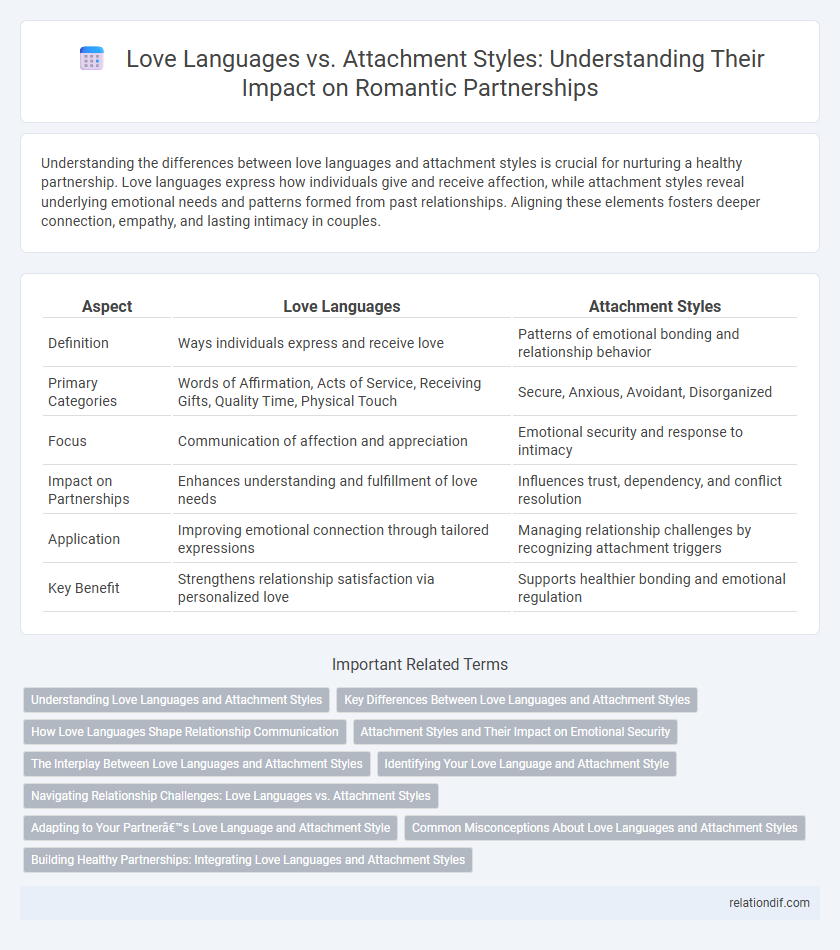Understanding the differences between love languages and attachment styles is crucial for nurturing a healthy partnership. Love languages express how individuals give and receive affection, while attachment styles reveal underlying emotional needs and patterns formed from past relationships. Aligning these elements fosters deeper connection, empathy, and lasting intimacy in couples.
Table of Comparison
| Aspect | Love Languages | Attachment Styles |
|---|---|---|
| Definition | Ways individuals express and receive love | Patterns of emotional bonding and relationship behavior |
| Primary Categories | Words of Affirmation, Acts of Service, Receiving Gifts, Quality Time, Physical Touch | Secure, Anxious, Avoidant, Disorganized |
| Focus | Communication of affection and appreciation | Emotional security and response to intimacy |
| Impact on Partnerships | Enhances understanding and fulfillment of love needs | Influences trust, dependency, and conflict resolution |
| Application | Improving emotional connection through tailored expressions | Managing relationship challenges by recognizing attachment triggers |
| Key Benefit | Strengthens relationship satisfaction via personalized love | Supports healthier bonding and emotional regulation |
Understanding Love Languages and Attachment Styles
Understanding love languages and attachment styles is crucial for building and maintaining strong partnerships. Love languages--such as words of affirmation, acts of service, receiving gifts, quality time, and physical touch--represent how individuals express and receive love, while attachment styles--secure, anxious, avoidant, or disorganized--reflect underlying emotional bonding patterns rooted in early experiences. Recognizing and respecting these differences enhances communication, empathy, and emotional intimacy between partners.
Key Differences Between Love Languages and Attachment Styles
Love languages describe the ways individuals express and receive affection, such as acts of service, words of affirmation, or physical touch, while attachment styles reflect patterns of emotional bonding and security, categorized as secure, anxious, avoidant, or disorganized. Love languages focus on communication preferences in relationships, whereas attachment styles influence fundamental responses to intimacy and trust. Understanding these distinctions helps partners navigate emotional needs and improve relational dynamics effectively.
How Love Languages Shape Relationship Communication
Love languages profoundly influence relationship communication by defining how partners express and perceive affection, which directly impacts emotional connection and conflict resolution. Understanding each other's primary love language--such as words of affirmation, acts of service, or physical touch--facilitates clearer emotional exchanges and reduces misunderstandings linked to attachment styles. Integrating knowledge of love languages with attachment theory enables couples to tailor their interactions, promoting secure bonds and effective communication patterns.
Attachment Styles and Their Impact on Emotional Security
Attachment styles play a crucial role in shaping emotional security within partnerships by influencing how individuals seek and respond to intimacy and support. Secure attachment fosters trust and open communication, enhancing emotional safety, while anxious and avoidant styles often lead to misunderstandings and emotional distance. Understanding these patterns allows partners to address insecurities, build stronger bonds, and navigate conflicts with greater empathy.
The Interplay Between Love Languages and Attachment Styles
The interplay between love languages and attachment styles shapes how partners express and perceive affection, influencing relationship satisfaction and emotional intimacy. Understanding one's primary love language alongside attachment patterns such as secure, anxious, or avoidant attachment helps tailor communication strategies to meet emotional needs effectively. Integrating love languages with attachment theory enhances empathy and reduces conflicts by aligning affectionate behaviors with core emotional expectations.
Identifying Your Love Language and Attachment Style
Identifying your love language and attachment style is crucial for fostering a healthy partnership, as love languages like words of affirmation or physical touch reveal how you express and receive affection, while attachment styles--secure, anxious, avoidant, or disorganized--describe your expectations and behavior in relationships. Understanding that your partner may interpret love differently based on their unique attachment style allows for tailored communication and conflict resolution strategies. This dual awareness enhances emotional intimacy and resilience, promoting a deeper and more supportive connection.
Navigating Relationship Challenges: Love Languages vs. Attachment Styles
Navigating relationship challenges requires understanding how love languages and attachment styles interact to shape emotional expression and connection. Love languages focus on preferred ways of giving and receiving affection, while attachment styles reveal deeper patterns of security and trust formed in early relationships. Recognizing these differences helps partners address misunderstandings and build stronger, more empathetic bonds.
Adapting to Your Partner’s Love Language and Attachment Style
Adapting to your partner's love language and attachment style fosters deeper emotional connection and trust within the partnership. Recognizing whether they prioritize acts of service, words of affirmation, or physical touch helps tailor your expressions of affection effectively. Understanding their attachment style--secure, anxious, avoidant, or disorganized--allows for sensitive communication that supports their emotional needs and strengthens relationship resilience.
Common Misconceptions About Love Languages and Attachment Styles
Common misconceptions about love languages and attachment styles include the belief that love languages alone dictate relationship satisfaction, ignoring the complex influence of underlying attachment patterns formed in early childhood. Many assume that matching love languages guarantees compatibility, while attachment styles such as secure, anxious, or avoidant play a crucial role in emotional regulation and intimacy needs. Understanding the interaction between love languages and attachment styles provides a more comprehensive framework for addressing relationship challenges.
Building Healthy Partnerships: Integrating Love Languages and Attachment Styles
Building healthy partnerships requires understanding how love languages and attachment styles interact to shape emotional connection. Recognizing each partner's primary love language--such as words of affirmation or acts of service--enhances communication and affection expression. Aligning this with attachment styles, like secure or anxious, fosters empathy and resilience, creating a balanced, supportive relationship foundation.
love languages vs attachment styles Infographic

 relationdif.com
relationdif.com